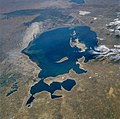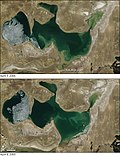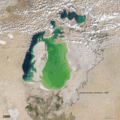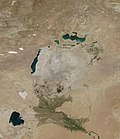Aral Sea
former lake between Kazakhstan and Uzbekistan From Wikipedia, the free encyclopedia
Remove ads
The Aral Sea (Kazakh: Арал теңізі (Aral tengizi), Uzbek: Orol dengizi, Russian: Аральскοе мοре) was a lake in Central Asia. It is between Kazakhstan in the north and Karakalpakstan, an autonomous region of Uzbekistan, in the south.
Since the 1960s, the Aral Sea shrank. 90% of the sea has gone.[3] The rivers that fed it (the Amu Darya and the Syr Darya) were used by the Soviet Union for irrigating cotton production. What is left of the Aral Sea is heavily polluted, largely as the result of weapons testing, industrial projects, and fertilizer runoff before and after the breakup of the Soviet Union.[3]
There is a project to save at least the northern part of the Aral Sea. For this, a dam was built in the 1990 to stop water running off. Climate improved in the following years, and water levels rose again. However, that dam broke, and was rebuilt in 2005, with international funding.[4]
Another problem was that Rebirth Island had been used for the testing of biological weapons until 1993. It is currently contaminated with anthrax, the plague, and tularemia. Since 2001, it is no longer an island, but a part of the mainland.
Remove ads
Gallery
- Map of the Aral Sea in 1853.
- Satellite image of the Aral Sea taken in 1985. (south at the top)
- Satellite image of the Aral Sea taken in 1997. (south at the top)
- 2004 photo of the Aral Sea (The black lines are where it was in 1850)
- Rebirth island (an island in the Aral Sea) joins the mainland (2000/2001)
- North Aral Sea, comparison April 2005/2006 (showing the sea has grown)
- Shrinking of the Aral Sea 1960-2014
- Aral Sea Animation 2000-2011.
- The East Aral Sea completely dries up in 2014
- The East Aral Sea is reflooded in 2018
- The East Aral Sea dries up again in 2021
- A Boat on what used to be the Aral Sea
- A Harbor off what used to be the Aral Sea
Remove ads
References
Other websites
Wikiwand - on
Seamless Wikipedia browsing. On steroids.
Remove ads














